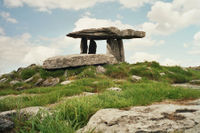- Orthostat
-
Als Orthostaten bezeichnet man allgemein die großen, aufrecht stehenden Steinblöcke der untersten Lage eines Mauerwerks. Dieses Bauelement wurde häufig im Burgenbau oder bei antiken Tempeln verwendet.
Dieser Begriff ist jedoch mittlerweile veraltet und wird nur noch von Archäologen benutzt, um einzelne prähistorische Steine zu beschreiben, wenn sie Teil eines größeren Komplexes sind. Das bekannteste Beispiel dafür, wie sie in megalithischen Anlagen verwendet wurden, ist Stonehenge.
Wikimedia Foundation.

